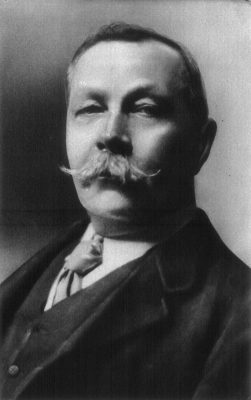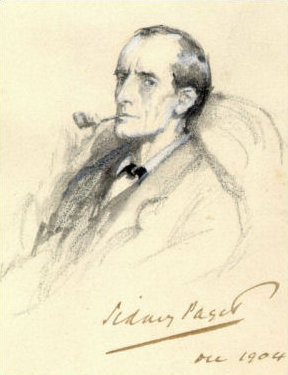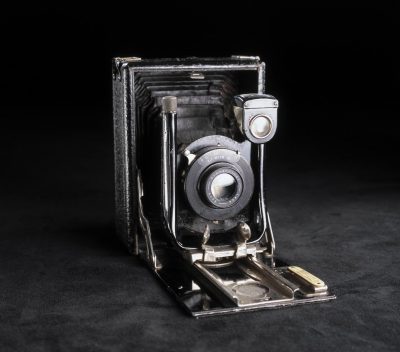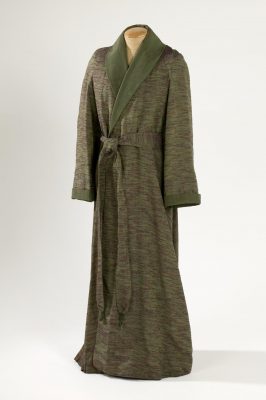
Born on this day, 22 May, in 1859, Arthur Conan Doyle is most readily connected with science and medicine through the brilliant scientific mind and forensic approach of his most famous creations, the consulting detective Sherlock Holmes and his assistant Dr John Watson, as well as his own studies and early professional experience in various fields of medicine.
Perhaps unsurprisingly, it is objects related to Conan Doyle’s writing output and popular culture representations rather than those connected with his scientific and medical background and interests which have made it into the Science Museum Group (SMG) collection.
These objects include an early silent film poster for ‘Canine Sherlock Holmes’ and a first edition of Conan Doyle’s ‘The Coming of the Fairies’ from 1922, along with objects related to the Cottingley Fairies held by the National Science and Media Museum in Bradford and a dressing gown worn by Jeremy Brett in the role of Sherlock Holmes for Granada Television belonging to the Museum of Science and Industry in Manchester.
A Dog Detective

The earliest item in the SMG collection (loosely) related to Arthur Conan Doyle is a contemporary poster for ‘A Canine Sherlock Holmes‘, a rare British silent film, produced by Charles Urban of the Charles Urban Trading Company. The short film, a rare copy of which has survived in the Jean Desmet Collection in the EYE Film Institute in the Netherlands, was released in 1912 and starred Spot, the Urbanora dog, as the Canine Sherlock Holmes of the title.
The film combined a cultural recognition of Sherlock Holmes with the popularity of canine stars on screen. The latter trend may have begun with stray dogs wandering into the shot in early silent films but was rapidly superseded by the use of trained dogs in early twentieth century films and beyond.
The earliest documented example of the use of trained dogs in film was the 1905 British silent film ‘Rescued by Rover’ where our canine hero tracks down a kidnapped child while the human members of the family are overcome with grief and panic. Self-described as “the sensation of the new century”, ‘Rescued by Rover’ was written, produced, directed, and photographed by Cecil Hepworth – one of the founders of the British film industry – who also starred in the film alongside his wife Margaret Hepworth and their family dog Blair who played Rover, as well as two professional actors.
Such was the popularity of the film that it was re-shot two or three times when the film’s popularity led to the negatives being worn out. The film also led to the name ‘Rover’ becoming a popular name for dogs and Blair the dog has been celebrated as ‘the first canine film star.’
Following in its footsteps, ‘A Canine Sherlock Holmes’ continued the popular trope of dogs outsmarting their human counterparts and additionally used the recognition of Sherlock Holmes to heighten interest in the film. By 1912, when the film was released, Sherlock Holmes and the fictional detective genre were sufficiently well-known and understood for a slightly tongue-in-cheek, and blissfully copyright-unaware, doggy version to be released on film.

Over twenty years before the release of ‘A Canine Sherlock Holmes’, Conan Doyle first published works featuring Sherlock Holmes and Dr Watson in ‘A Study in Scarlet’, published as a novella in 1886 and a year later as a short story in Beeton’s Christmas Annual. ‘A Study in Scarlet’ was written while Conan Doyle was running his private medical practice at Southsea. The medical practice was not particularly financially prosperous and so he turned to his passion for writing to bring in a further income.
Although Conan Doyle wrote a second Sherlock Holmes novel ‘The Sign of Four’ in 1890, he soon realised short stories provided a better source of income. As a result, between 1891 and 1892 he published the first twelve ‘Adventures of Sherlock Holmes’ stories in the Strand Magazine, which were turned into a successful book of the same title in 1892. One year later in 1893, “the Baker Street mania” was such that Conan Doyle killed off Holmes, hoping to concentrate on more serious writing. Public outcry forced him to bring the character back to life and continued to write and publish short stories, novellas, and novels on Sherlock Holmes and Dr Watson alongside his more serious fiction and non-fiction writings.
Fairies
Conan Doyle had a strong interest in mysticism, spiritualism, and psychic investigations dating back to the early years of his Southsea medical practice in the early 1880s. It was also around this time that Conan Doyle privately declared his religious and spiritual beliefs to be ‘Spiritualism’ with the author publicly declaring these beliefs in the midst of the Great War in 1916, in part a response to the multitude of deaths in the war, including some witnessed personally on a visit to the Western Front in 1916.
However, it was the later deaths of a number of close family members including his son and brother which further encouraged Conan Doyle’s fascination with spiritualism: his son Kingsley died in 1918 from pneumonia, worsened by being seriously wounded in the Battle of the Somme two years earlier, while his brother Brigadier-General Innes Doyle, also died from pneumonia, in February 1919. Two of Conan Doyle’s nephews had been killed earlier in the war: one was killed in action in July 1915, aged 20 while another died of wounds in September 1916, aged 28.
It was said Conan Doyle found solace in the idea of life beyond the grave. He wrote prolifically on the subject, publishing three books, ‘The New Revelation’ (1918), ‘The Vital Message’ (1919), and ‘The Wanderings of a Spiritualist’ (1921), with Hodder & Stoughton.

It was around this time, in the early 1920s, that Conan Doyle began researching fairies and came across photographs taken in 1917 using a ‘Midg’ camera belonging to a family in Cottingley, rural Yorkshire, now on display at the National Science and Media Museum. The photographs, which seemed not having been tampered with, appeared to show several small fairies dancing under the careful watch of two young girls, Elsie Wright and her cousin Frances Griffiths. The technical and photographic skills used by the teenage Elsie Wright to produce these photographs, which were particularly unusual for a woman of this time, have often been overlooked.
A second phase of fairy photographs were taken between 1918 and 1920, using a Kodak ‘Cameo’ photographic camera (shown left and now on display in the Kodak Gallery at the National Science and Media Museum), provided by Edward Gardner, a leading member of the Theosophical Society in Bradford, where the original fairy photographs from 1917 had first been made public in 1919.
Conan Doyle championed the photographs and their female subjects, eventually publishing them in his 1922 illustrated book The Coming of the Fairies, a first edition of which is held at the Museum of Science and Industry in Manchester.
For this contentious publication, Conan Doyle was widely ridiculed by the public, press, and priesthood. The publication was representative of the genres of spiritualism and the occult which flourished in the immediate post-war years as individuals, families, and nations attempted to make sense of the first war conducted on a truly industrial scale and the resulting deaths in their millions, from war as well as influenza.
Sherlock Holmes’ dressing gown

The final and most recent item related to Conan Doyle in the SMG Collection is Sherlock Holmes’ dressing gown, as used by the British actor Jeremy Brett in his portrayal of the consulting detective in various Granada Television productions between 1984 and 1994. Brett’s portrayal of Sherlock Holmes is widely regarded as one of the best if not the best Sherlock Holmes. Alongside the actor’s striking similarity to the Sidney Paget illustrations of Holmes (shown above) accompanying Conan Doyle’s original editions, Brett left ‘an indelible legacy on the character’ of Sherlock Holmes with the production in which he starred considered the single best adaptation of Conan Doyle’s works.
Nearly a century after Conan Doyle first committed Sherlock Holmes to print and over fifty years after Conan Doyle’s death, the unique character and mannerisms of the consulting detective, along with his iconic deerstalker hat and dressing gown live on in print, on stage and screen, and beyond in popular culture.
Summary
The three items above show the diversity of the SMG Collection. Dating from opposite ends of the twentieth century, ‘A Canine Sherlock Holmes’ and Sherlock Holmes’ dressing gown highlight the enduring popularity of Conan Doyle’s character. Meanwhile, the more personal ‘The Coming of the Fairies’ (1922) as well as artefacts relating to the photographs on display at the National Science and Media Museum reveal the deeply personal and tragic impact of the Great War on the life, writings, and beliefs of Conan Doyle himself.